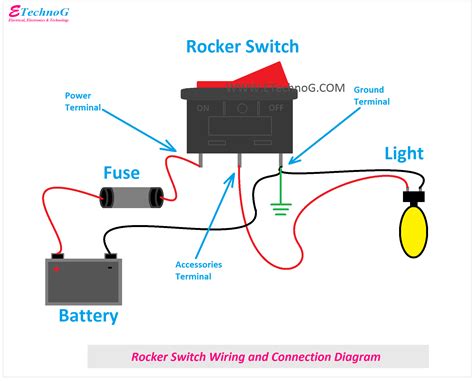Wiring a Rocker Switch Panel: A Visual Guide
Installing a rocker switch panel can dramatically enhance your vehicle's or project's functionality and aesthetics. Whether you're adding auxiliary lights, powering a winch, or upgrading your audio system, understanding how to wire a rocker switch panel safely and effectively is crucial. This comprehensive guide provides a step-by-step visual walkthrough (while not actually displaying visuals due to the text-only format), supplementing the explanations with clear instructions to help you successfully complete your project.
What You'll Need
Before you begin, gather all the necessary components. This typically includes:
- Rocker Switch Panel: Choose a panel that matches your needs in terms of the number of switches and overall size.
- Rocker Switches: Select switches rated for the appropriate amperage based on the devices you’re powering. Always choose a higher amperage rating than needed for a safety margin.
- Wiring: Use appropriately sized wiring for your application. Too small of a wire can overheat and cause a fire. Consult an amperage chart to determine the correct wire gauge.
- Relays (Recommended): Relays are highly recommended, especially for high-amperage devices. They protect your switches and vehicle's wiring.
- Fuses (Essential): Fuses protect your circuit and prevent damage to your vehicle's electrical system. Always use fuses appropriate for the amperage of the circuit.
- Wire Connectors: Crimp-style connectors are generally preferred for their secure and reliable connections.
- Tools: Screwdrivers (Phillips and flathead), wire strippers/cutters, crimp tool, multimeter (recommended for testing circuits), electrical tape.
Step-by-Step Wiring Guide
1. Planning Your Wiring Layout
Before you start connecting wires, carefully plan your circuit layout. Determine which switch will control which device and how you'll route the wiring. A clean, organized wiring job is safer and easier to troubleshoot. Consider using a diagram to help visualize the connections.
2. Preparing the Switches and Panel
Most rocker switch panels come with pre-drilled holes for mounting the switches. Securely install your switches into the panel.
3. Connecting the Wires to the Switches
Each switch typically has three terminals:
- Power In (Positive): This connects to the positive side of your power source.
- Load Out (Positive): This connects to the positive side of the device you’re controlling (through a relay if using one).
- Ground (Negative): This connects to the negative side of your power source.
Connect the wires to the correct terminals, following the wiring diagram provided with your switches or a pre-planned diagram of your own design.
4. Understanding and Using Relays
Relays are essential for high-current devices because they protect your switches from excessive current flow. A relay is a simple electromechanical switch that uses a low-current signal to control a high-current circuit.
- Coil: The coil is activated by a low-current signal from your switch.
- Contacts: When the coil is energized, the contacts close, completing the high-current circuit.
The coil connects to the switch's output, while the contacts connect to the power source and the device.
5. Installing Fuses
Fuses are indispensable for safety. They protect your circuit from overcurrent conditions. Place a fuse in-line with the power source, before the power reaches the switch.
6. Grounding the System
Proper grounding is vital for safe operation and is often overlooked. A solid ground connection ensures the current has a safe return path. The ground wire should be connected to a reliable chassis ground point.
7. Testing the Circuit
Before permanently mounting the panel, test each circuit individually with a multimeter to ensure the connections are correct and the fuses are functioning correctly.
8. Mounting and Securing the Panel
Once you've tested the circuit, mount the panel securely in your desired location.
9. Final Checks and Clean Up
After mounting, perform a final check to ensure all connections are secure and the wires are properly routed and secured using zip ties or cable clamps.
Troubleshooting Common Issues
- Switch Doesn't Work: Check the fuse, wire connections, and the switch itself. Use a multimeter to test for voltage and continuity.
- Blown Fuse: This indicates a short circuit or an overcurrent condition. Investigate the circuit carefully for faulty wiring or a malfunctioning device.
- Intermittent Operation: Look for loose connections or damaged wiring.
Frequently Asked Questions (FAQs)
How do I choose the right size wire for my rocker switch panel? The wire gauge depends on the amperage of the devices you’re powering. Consult a wire gauge chart to determine the appropriate size wire for your specific application. Always err on the side of caution and use a larger gauge wire than you might think you need.
What type of fuses should I use? Use fuses that are rated for the appropriate amperage of the circuit. Using a fuse with too low an amperage rating will cause it to blow unnecessarily. A fuse with too high a rating won't protect your circuit.
Do I need to use relays? While not strictly necessary for low-current devices, relays are highly recommended for high-current applications to protect your switches and vehicle’s wiring.
Where should I ground my rocker switch panel? Ground the panel to a clean, bare metal surface on the chassis of your vehicle or project.
This guide provides a solid foundation for wiring a rocker switch panel. Remember to always prioritize safety and use appropriate safety precautions. If you are unsure about any aspect of the installation process, consult a qualified electrician. Happy wiring!

